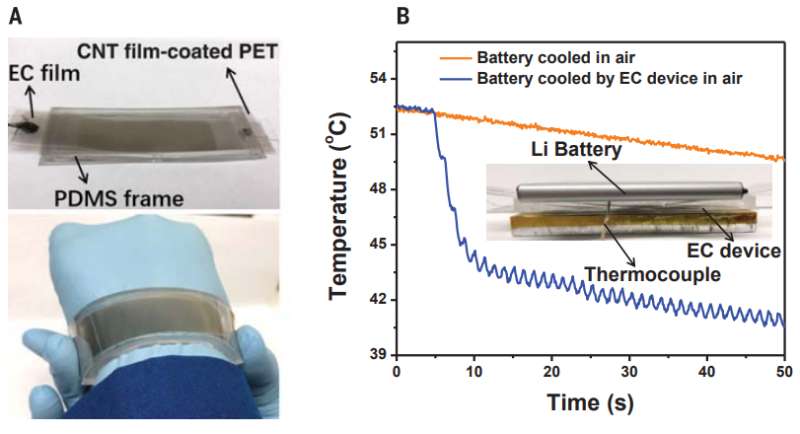September 15, 2017 report
A new efficient and portable electrocaloric cooling device

(Phys.org)—A team of researchers with the University of California and SRI International has developed a new type of cooling device that is both portable and efficient. In their paper published in the journal Science, the team describes their new device and possible applications for its use. Q.M. Zhang and Tian Zhang with the Pennsylvania State University offer some background on electrocaloric theory and outline the work done by the team in California in a Perspectives piece in the same journal issue.
As most everyone knows, conventional air conditioners are bulky, heavy, use a lot of electricity and often leak greenhouse gases into the atmosphere. Thus, conditions are ripe for something new. Some new devices have been developed such as thermoelectric coolers, which make use of ceramics, but they are not efficient enough to play a major role in cooling. A more recent development is the use of devices exploiting the electrocaloric effect, which is where heat moves through certain materials when an electric current is applied. In this new effort, the researchers used a polymer as the material.
The new cooling device was made by layering a polymer between a heat sink and a heat source. Applying electric current to the polymer when it was touching the heat sink caused its molecules to line up, which reduced entropy, forcing heat into the sink. The polymer was then moved into contact with the heat source while the current was turned off. The molecules relaxed, which caused the temperature to drop. Repeating this process resulted in cooling.
The researchers report that the device is extremely efficient, portable and configurable. They suggest the same technology could be used to create coolers for a chair or hat, for example, or perhaps to chill smartphone batteries. They proved this last claim by actually building such a device and using it to cool down a battery heated by ordinary use—after only five seconds, the temperature of the battery had lessened by 8° C. Comparatively, air cooling the battery reduced its temperature just 3° C in 50 seconds.
More information: Rujun Ma et al. Highly efficient electrocaloric cooling with electrostatic actuation, Science (2017). DOI: 10.1126/science.aan5980
Abstract
Solid-state refrigeration offers potential advantages over traditional cooling systems, but few devices offer high specific cooling power with a high coefficient of performance (COP) and the ability to be applied directly to surfaces. We developed a cooling device with a high intrinsic thermodynamic efficiency using a flexible electrocaloric (EC) polymer film and an electrostatic actuation mechanism. Reversible electrostatic forces reduce parasitic power consumption and allow efficient heat transfer through good thermal contacts with the heat source or heat sink. The EC device produced a specific cooling power of 2.8 watts per gram and a COP of 13. The new cooling device is more efficient and compact than existing surface-conformable solid-state cooling technologies, opening a path to using the technology for a variety of practical applications.
Journal information: Science
© 2017 Phys.org




















